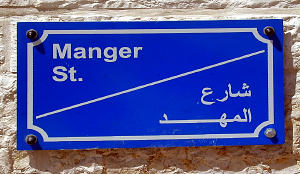 |
Bethlehem |
| After lunch we headed out of Jerusalem to
Bethlehem, through the "border" into one of the areas under
the administration of the Palestinian Authorities.
At the time, everything was calm and still decorated following a visit from the Pope as part of his millenium celebrations. Less than a year later, there was fierce fighting between the Palestinians and Jews in Bethlehem, and tours like ours simply did not happen. |
|
| Manger Square is dominated on one side by the Mosque. The current population of Bethlehem is 50% Christians and 50% Muslims. | |
| The Church of the Nativity is the site where
Christ is believed to have been born (in a small cave used as a stable
by the local inn). The approach and entrance to the Church is rather
unimposing. The main entrance has been reduced to one small door to make
it easier to defend.
The facade of the nearby Milk Grotto Church (so called because legend has it that the floor is white because Mary's milk splashed to the floor while she was feeding Jesus) is rather more imposing. |
|
| Our experiences of the morning in the Church
of the Holy Sepulchre were repeated here.
What should be one of the most sacred places in the world for Christians, the Church of the Nativity, is just another stop on the tourist trail. Inside there are crowds jostling for position, much shouting and pushing. The grotto itself is now a heavily decorated cave with a star on the floor where Jesus is supposed to have been born. Once again we were glad to get out. |
|
| Stained glass windows in the Church of the Nativity. |
Last updated on July 13, 2001